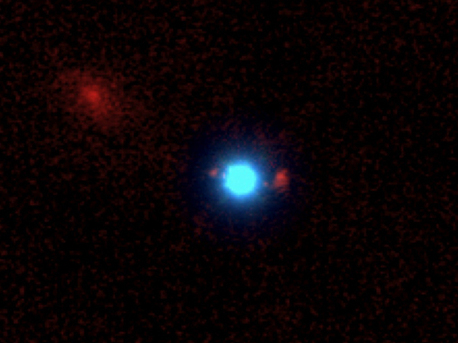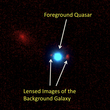Quasars
Reverse cosmic lens advances quasar studies
 © F. Courbin, G. Meylan, S. G. Djorgovski, et al., EPFL/ Caltech/WMKO
|
This unlabeled image of the first-ever foreground quasar (blue) lensing a background galaxy (red) was taken with the Keck II telescope and its NIRC-2 instrument using laser guide star adaptive optics. Discovering more of these lenses will allow astronomers to determine the masses of quasars’ host galaxies.
“It is a bit like staring into bright car headlights and trying to discern the color of their rims,” said astronomer Frederic Courbin of the Ecole Polytechnique Federale de Lausanne, or EPFL, in Switzerland.
The new “reverse” quasar-galaxy gravitational lens, described by Courbin and his colleagues in the July 16 Astronomy & Astrophysics, provides a way to tell something about the host galaxy, such as its mass. This is important to studying how the galaxy itself relates to the central supermassive black hole.
According to Einstein’s theory of general relativity, a gravitational lens occurs when a large mass—a quasar, large galaxy or cluster of galaxies—is placed along the line of sight to a distant galaxy. As light from the distant galaxy travels toward Earth and interacts with the large mass, the distant object’s light rays are bent and re-directed. On Earth, an observer sees this interaction as two or more close images of the magnified background galaxy.
Astronomers discovered the first quasar gravitationally lensed by a foreground galaxy in 1979. Since then, they have found many more examples of quasar-galaxy gravitational lenses, allowing researchers to calculate the masses of the foreground galaxies.
There has not been an example of the reverse process—a background galaxy being lensed by the massive host galaxy of a foreground quasar—until now.
“We were delighted to see that this idea actually works,” said Georges Meylan, the leader of the EPFL team. “This discovery demonstrates the continued utility of gravitational lensing as an astrophysical tool.”
To find potentially lensing quasars, astronomers from EPFL and the California Institute of Technology, or Caltech, searched a large database of quasar spectra obtained by the Sloan Digital Sky Survey. The team selected candidates that showed evidence of reverse quasar-galaxy gravitational lensing.
Using the Keck II 10-meter telescope, the Near-Infrared Camera-2 (NIRC-2), and laser guide star adaptive optics to correct for the turbulence in the atmosphere, the astronomers imaged the candidate quasars. Pictures of one candidate revealed the signature multiple images of a lensed background galaxy.
With the Keck I 10-meter telescope and its Low Resolution Imaging Spectrograph, or LRIS, the team determined that the quasar is 1.6 billion light years from Earth and lenses a galaxy roughly 7.5 billion light years away. The astronomers also estimate that the inner kiloparsec, or 3200 light years, of the quasar’s host galaxy contains roughly 20 billion times the mass of the Sun.
“Quasars are valuable probes of galaxy formation and evolution,” said S. George Djorgovski, the leader of the Caltech team. “Discoveries of more of these systems will help us better understand the relationship between quasars and the galaxies which contain them, and their co-evolution.”
The Sloan Digital Sky Survey (SDSS) is one of the most ambitious and influential surveys in the history of astronomy. SDSS-III, a program of four new surveys using SDSS facilities, began observations in July 2008, and will continue through 2014. The SDSS used a dedicated 2.5-meter telescope at Apache Point Observatory, New Mexico, equipped with two powerful special-purpose instruments.
Source: W.M. Keck Observatory
Quasars
Reverse cosmic lens advances quasar studies
 © F. Courbin, G. Meylan, S. G. Djorgovski, et al., EPFL/ Caltech/WMKO
|
This unlabeled image of the first-ever foreground quasar (blue) lensing a background galaxy (red) was taken with the Keck II telescope and its NIRC-2 instrument using laser guide star adaptive optics. Discovering more of these lenses will allow astronomers to determine the masses of quasars’ host galaxies.
“It is a bit like staring into bright car headlights and trying to discern the color of their rims,” said astronomer Frederic Courbin of the Ecole Polytechnique Federale de Lausanne, or EPFL, in Switzerland.
The new “reverse” quasar-galaxy gravitational lens, described by Courbin and his colleagues in the July 16 Astronomy & Astrophysics, provides a way to tell something about the host galaxy, such as its mass. This is important to studying how the galaxy itself relates to the central supermassive black hole.
According to Einstein’s theory of general relativity, a gravitational lens occurs when a large mass—a quasar, large galaxy or cluster of galaxies—is placed along the line of sight to a distant galaxy. As light from the distant galaxy travels toward Earth and interacts with the large mass, the distant object’s light rays are bent and re-directed. On Earth, an observer sees this interaction as two or more close images of the magnified background galaxy.
Astronomers discovered the first quasar gravitationally lensed by a foreground galaxy in 1979. Since then, they have found many more examples of quasar-galaxy gravitational lenses, allowing researchers to calculate the masses of the foreground galaxies.
There has not been an example of the reverse process—a background galaxy being lensed by the massive host galaxy of a foreground quasar—until now.
“We were delighted to see that this idea actually works,” said Georges Meylan, the leader of the EPFL team. “This discovery demonstrates the continued utility of gravitational lensing as an astrophysical tool.”
To find potentially lensing quasars, astronomers from EPFL and the California Institute of Technology, or Caltech, searched a large database of quasar spectra obtained by the Sloan Digital Sky Survey. The team selected candidates that showed evidence of reverse quasar-galaxy gravitational lensing.
Using the Keck II 10-meter telescope, the Near-Infrared Camera-2 (NIRC-2), and laser guide star adaptive optics to correct for the turbulence in the atmosphere, the astronomers imaged the candidate quasars. Pictures of one candidate revealed the signature multiple images of a lensed background galaxy.
With the Keck I 10-meter telescope and its Low Resolution Imaging Spectrograph, or LRIS, the team determined that the quasar is 1.6 billion light years from Earth and lenses a galaxy roughly 7.5 billion light years away. The astronomers also estimate that the inner kiloparsec, or 3200 light years, of the quasar’s host galaxy contains roughly 20 billion times the mass of the Sun.
“Quasars are valuable probes of galaxy formation and evolution,” said S. George Djorgovski, the leader of the Caltech team. “Discoveries of more of these systems will help us better understand the relationship between quasars and the galaxies which contain them, and their co-evolution.”
The Sloan Digital Sky Survey (SDSS) is one of the most ambitious and influential surveys in the history of astronomy. SDSS-III, a program of four new surveys using SDSS facilities, began observations in July 2008, and will continue through 2014. The SDSS used a dedicated 2.5-meter telescope at Apache Point Observatory, New Mexico, equipped with two powerful special-purpose instruments.
Source: W.M. Keck Observatory









